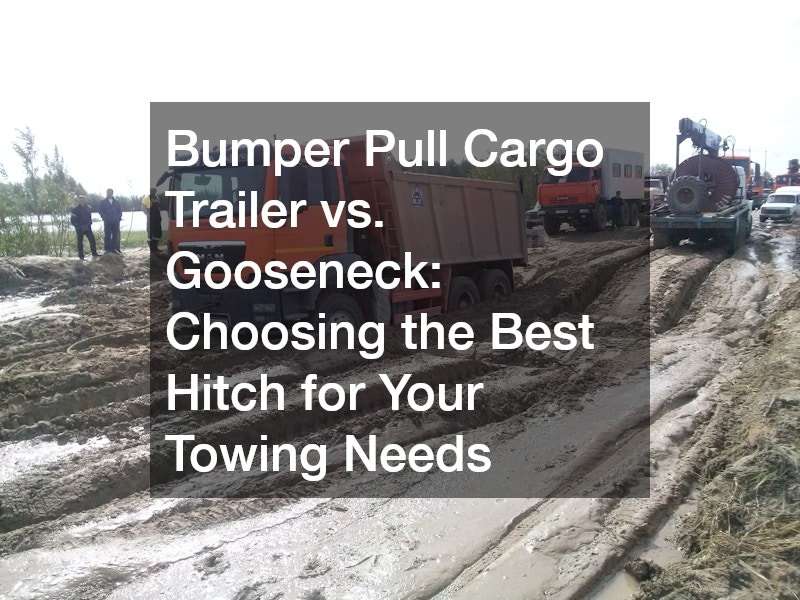
Bumper Pull Cargo Trailer vs. Gooseneck: Choosing the Best Hitch for Your Towing Needs When it comes to selecting the right trailer for your towing needs, the choice between a bumper pull cargo trailer and a gooseneck trailer is a critical decision. Each type of trailer offers unique benefits and drawbacks, and understanding these can help you make the best choice for your specific requirements.
In this article, we will delve into the differences between bumper pull and gooseneck trailers, exploring their advantages, disadvantages, and key considerations to help you decide which hitch type suits your needs.
Bumper Pull Cargo Trailer: Advantages and Disadvantages Advantages
Ease of Use: Bumper pull cargo trailers are often recommended for first-time trailer owners due to their simplicity. They connect to the hitch on the rear bumper of your vehicle, making them easier to attach and detach. This straightforward setup is suitable for a range of vehicles, including SUVs and even some cars, making them highly versatile.
Vehicle Compatibility: One of the primary benefits of a bumper pull cargo trailer is its compatibility with a wide range of vehicles. If you have a standard truck or SUV, you can usually equip it with a hitch suitable for a bumper pull trailer. This makes it accessible for those who may not own a heavy-duty truck.
Truck Bed Accessibility: Unlike gooseneck trailers, a bumper pull cargo trailer does not occupy the truck bed space. This means you can use the full bed of your truck for additional storage or cargo, which is ideal for those who need extra space.
Disadvantages
Capacity and Stability: Bumper pull cargo trailers generally have a smaller capacity compared to gooseneck trailers. This limitation can be a drawback if you need to haul heavy or oversized loads. Additionally, bumper pull trailers can be more prone to sway and instability, particularly if the load is not properly balanced.
Turning Radius: Another consideration with bumper pull trailers is the turning radius. Since the trailer pivots from the rear bumper, it requires wider turns compared to gooseneck trailers. This can make maneuvering in tight spaces or making sharp turns more challenging.
Load Capacity: Because bumper pull trailers are often smaller and less robust, they may not be suitable for carrying heavier loads. This can be a significant limitation if you need to transport large or heavy items regularly.
Gooseneck Trailers: Advantages and Disadvantages Advantages
Enhanced Stability: Gooseneck trailers offer superior stability compared to bumper pull cargo trailers. The hitch is mounted over the rear axle of the truck, which helps to distribute the weight more evenly and minimizes trailer sway. This setup allows for smoother towing, especially with heavier loads.
Increased Load Capacity: Gooseneck trailers generally have a higher load capacity than bumper pull trailers. This makes them ideal for hauling large or heavy items, such as construction equipment, vehicles, or multiple pallets of goods.
Improved Turning Radius: Gooseneck trailers provide a better-turning radius due to their hitch placement in the truck bed. This allows for tighter turns and more precise maneuvering, which can be particularly advantageous in confined or complex driving conditions.
Disadvantages
Vehicle Requirements: Gooseneck trailers require a special hitch installed in the truck bed, which typically necessitates a heavy-duty truck. If you don’t already own a suitable vehicle, this can be a significant additional expense.
Truck Bed Occupancy: One drawback of gooseneck trailers is that they occupy the truck bed space, which can limit your ability to use the bed for other purposes. This can be a disadvantage if you need to transport cargo or equipment alongside your trailer load.
Learning Curve: Driving with a gooseneck trailer can require a learning curve. Maneuvering with a gooseneck can be challenging, especially for those unfamiliar with the handling characteristics of these trailers.
Making Your Decision When choosing between a bumper pull cargo trailer and a gooseneck trailer, consider the following factors:
Load Requirements: Determine the types of loads you’ll be transporting and whether you need the higher capacity and stability of a gooseneck trailer or if a bumper pull trailer will suffice.
Vehicle Compatibility: Assess whether your current vehicle can handle the trailer you’re considering. Bumper pull trailers are more versatile with vehicle compatibility, while gooseneck trailers typically require a heavy-duty truck.
Usage and Maneuverability: Consider how often and in what conditions you will be towing. If you need to make frequent tight turns or navigate challenging terrain, a gooseneck trailer might be more suitable.
Ultimately, both bumper pull cargo trailers and gooseneck trailers have their own set of benefits and limitations. By evaluating your specific needs and vehicle capabilities, you can make an informed decision that ensures a more efficient and effective towing experience.
.

